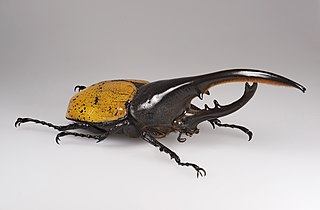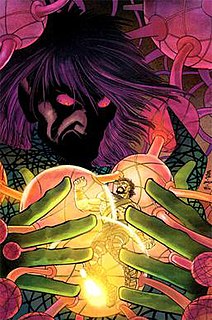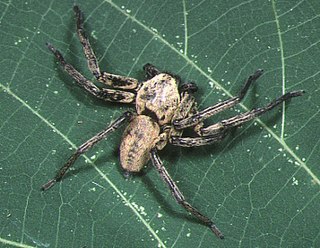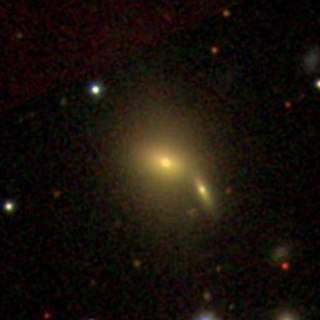
Jumping spiders or the Salticidae are a family of spiders. As of 2019, it contained over 600 described genera and over 6000 described species, making it the largest family of spiders at 13% of all species. Jumping spiders have some of the best vision among arthropods and use it in courtship, hunting, and navigation. Although they normally move unobtrusively and fairly slowly, most species are capable of very agile jumps, notably when hunting, but sometimes in response to sudden threats or crossing long gaps. Both their book lungs and tracheal system are well-developed, and they use both systems. Jumping spiders are generally recognized by their eye pattern. All jumping spiders have four pairs of eyes, with the anterior median pair being particularly large.

Huntsman spiders, members of the family Sparassidae, are known by this name because of their speed and mode of hunting. They are also called giant crab spiders because of their size and appearance. Larger species sometimes are referred to as wood spiders, because of their preference for woody places. In southern Africa the genus Palystes are known as rain spiders or lizard-eating spiders. Commonly they are confused with baboon spiders from the Mygalomorphae infraorder, which are not closely related.

The Amazing Spider-Man is an American television series about the Marvel Comics hero of the same name. It is the first live-action television series featuring Spider-Man and was shown in the United States from September 19, 1977 to July 6, 1979. Though it was a considerable ratings success, the CBS series was cancelled after just 13 episodes, which included a pilot film airing in autumn of 1977. Despite its storylines being set in New York City, the series was mostly filmed in Los Angeles.

The Hercules beetle is a species of rhinoceros beetle native to the rainforests of Central America, South America, and the Lesser Antilles. It is the longest extant species of beetle in the world, and is also one of the largest flying insects in the world.

Dynastes tityus, the eastern Hercules beetle, is a species of rhinoceros beetle that lives in the Eastern United States. The adult's elytra are green, gray or tan, with black markings, and the whole animal, including the male's horns, may reach 60 mm (2.4 in) in length. The grubs feed on decaying wood from various trees.

Nightmare is a fictional supervillain that appeared in the American comic books published by Marvel Comics. He first appeared in Strange Tales #110 and was created by Stan Lee and Steve Ditko. The character is depicted most commonly as one of Doctor Strange and Ghost Rider's major enemies. Nightmare is the ruler of a Dream Dimension and he is one of the Fear Lords. He is also part of the group called The Six Fingered Hand. He also has the ability to draw power from the psychic energies of the subconscious minds of dreaming beings.
The Man-Bull is a fictional character, a supervillain appearing in American comic books published by Marvel Comics.

Hercules is a fictional superhero appearing in American comic books published by Marvel Comics.
Spider-Man and Friends was a line of action figures and related merchandise featuring the comic book character Spider-Man and other characters appearing in Marvel Comics publications, released by Marvel Entertainment's toy division, Toy Biz, from 2003 to 2006. The line was aimed primarily at preschool-age children, and the character likenesses used were often altered to seem "cuter" and more childlike ; most characters were depicted as wide-eyed and smiling, even supervillains and characters better known for anger or savagery, such as the Incredible Hulk or Wolverine.

Thelcticopis is a genus of huntsman spiders that occurs almost exclusively in the Australasian region, from India to Japan to New Guinea and Fiji. However, one species occurs in Costa Rica, and another in Congo basin, although the latter species is probably misplaced in this genus.

Amadeus Cho, also known as Iron Spider, Mastermind Excello, Prince of Power, Hulk, and Brawn, is a fictional superhero appearing in American comic books published by Marvel Comics. Created by American writer Greg Pak and Canadian artist Takeshi Miyazawa, the character first appeared in Amazing Fantasy vol. 2 #15. Cho usually appears in books featuring the Avengers or individual members of that group, such as the Hulk or Hercules.

The Maestro is a fictional supervillain appearing in American comic books published by Marvel Comics. Created by writer Peter David and artist George Pérez, the character first appeared in The Incredible Hulk: Future Imperfect #1. Depicted as a version of the Hulk from an alternate future, the Maestro possesses Bruce Banner's intelligence and the Hulk's more malevolent personality traits.

Griffin is a fictional character appearing in American comic books published by Marvel Comics. He is the father of Yo-Yo Rodriguez.

Spiders are air-breathing arthropods that have eight legs, chelicerae with fangs generally able to inject venom, and spinnerets that extrude silk. They are the largest order of arachnids and rank seventh in total species diversity among all orders of organisms. Spiders are found worldwide on every continent except for Antarctica, and have become established in nearly every habitat with the exceptions of air and sea colonization. As of July 2019, at least 48,200 spider species, and 120 families have been recorded by taxonomists. However, there has been dissension within the scientific community as to how all these families should be classified, as evidenced by the over 20 different classifications that have been proposed since 1900.

Thelcticopis severa is a species of huntsman spider found in China, Laos, Korea, and Japan. It is the type species for the genus Thelcticopis, and was first described by Charles Athanase Walckenaer in 1875.
Stasina is a genus of huntsman spiders that was first described by Eugène Louis Simon in 1877. Many former species have been transferred to Thelcticopis and Neostasina.

NGC 6040 is a spiral galaxy located about 550 million light-years away in the constellation Hercules. NGC 6040 was discovered by astronomer Édouard Stephan on June 27, 1870. NGC 6040 is interacting with the lenticular galaxy PGC 56942. As a result of this interaction, NGC 6040's southern spiral arm has been warped in the direction toward PGC 56942. NGC 6040 and PGC 56942 are both members of the Hercules Cluster.

NGC 6043 is a lenticular galaxy located about 444 million light-years away in the constellation Hercules. NGC 6043 was discovered by astronomer Lewis Swift on June 27, 1886. The galaxy is a member of the Hercules Cluster.

NGC 6044 is a lenticular galaxy located about 465 million light-years away in the constellation Hercules. NGC 6044 was discovered by astronomer Lewis Swift on June 27, 1886. It was then rediscovered by astronomer Guillaume Bigourdan on June 8, 1888. NGC 6044 is a member of the Hercules Cluster.

NGC 6045 is a barred spiral galaxy located about 450 million light-years away in the constellation Hercules. NGC 6045 was discovered by astronomer Lewis Swift on June 27, 1886 and is a member of the Hercules Cluster. It is also a LINER galaxy.















